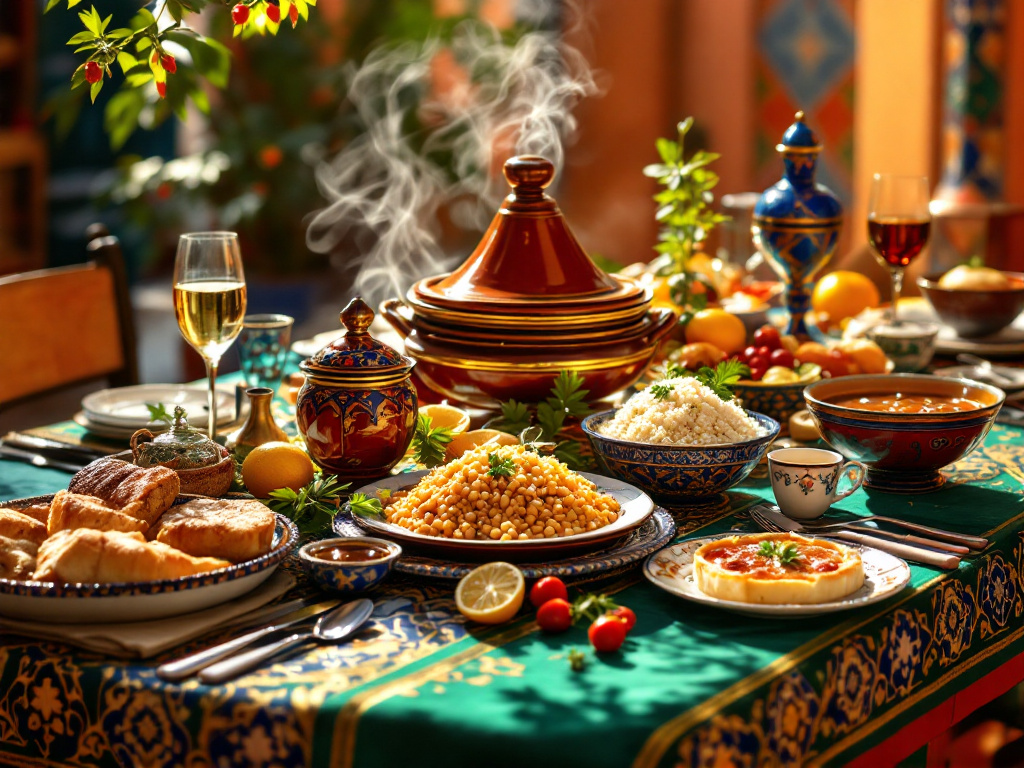What’s your favorite Moroccan dish? Have you tried any of these traditional recipes? Share your thoughts in the comments below, and The Flavors of Morocco are a vibrant blend of tastes, spices, and traditions that reflect the country’s rich history and cultural diversity. From fragrant tagines to comforting couscous, each dish tells a story of Morocco’s culinary heritage. Ready to explore the bold and unforgettable Flavors of Morocco? Here are 5 traditional Moroccan dishes you must try. They will take your taste buds on a journey to the heart of Morocco.
1. Tagine: The Icon of Moroccan Cuisine
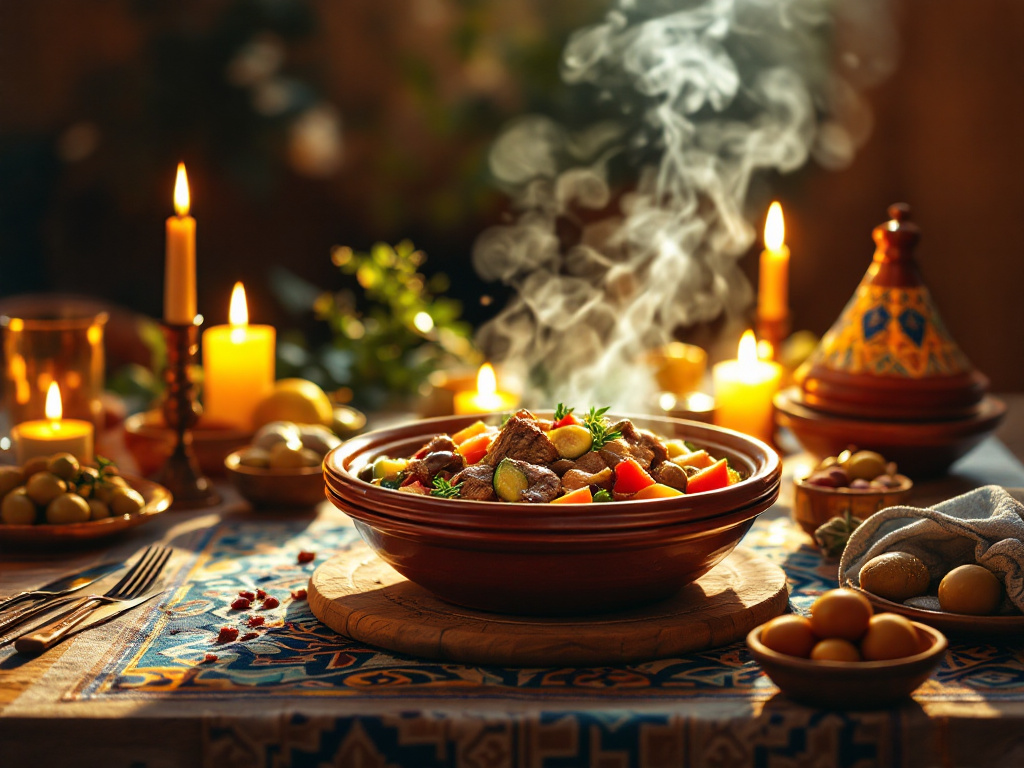
ming clay tagine pot filled with tender meat, aromatic spices, and vegetables, embodying the rich Flavors of Morocco.
The tagine is the first dish that comes to mind when thinking of the Flavors of Morocco. It’s named after the earthenware pot it’s cooked in. This slow-cooked stew is a masterpiece of flavors. The tagine pot’s design allows the ingredients to simmer gently, creating tender meat, fragrant vegetables, and a rich, spiced sauce.
Popular Tagine Variations:
- Chicken Tagine with Preserved Lemons and Olives: A zesty and savory classic.
- Lamb Tagine with Prunes and Almonds: A sweet and savory combination that’s unforgettable.
- Vegetable Tagine: A lighter, vegetarian-friendly option packed with seasonal produce.
Ingredients
The ingredients for a tagine can vary depending on the type (chicken, lamb, beef, or vegetarian), but here’s a common list for a Chicken Tagine with Preserved Lemons and Olives:
- Chicken: 1 whole chicken (cut into pieces) or 4-6 chicken thighs.
- Onions: 2 large, finely chopped.
- Garlic: 3-4 cloves, minced.
- Preserved lemons: 1-2, quartered.
- Green or purple olives: 1 cup.
- Spices:
- 1 tsp ground ginger.
- 1 tsp turmeric.
- 1 tsp paprika.
- 1 tsp ground cinnamon (optional).
- Salt and pepper to taste.
- Fresh herbs: Cilantro and parsley, chopped (about 1/4 cup each).
- Olive oil: 2-3 tbsp.
- Water or chicken stock: 1-2 cups.
Optional additions: saffron threads, carrots, potatoes, or other vegetables.
Preparation Technique
- Marinate the chicken:
- Mix the chicken with garlic, ginger, turmeric, paprika, salt, pepper, and a drizzle of olive oil. Let it marinate for at least 1 hour (or overnight in the fridge for better flavor).
- Prepare the tagine base:
- Heat olive oil in the base of the tagine (or a heavy-bottomed pot if you don’t have a tagine).
- Add the chopped onions and cook until softened.
- Cook the chicken:
- Place the marinated chicken pieces on top of the onions.
- Add the preserved lemons, olives, and any optional vegetables.
- Add liquid:
- Pour in enough water or chicken stock to partially cover the chicken.
- Simmer gently:
- Cover the tagine with its lid and cook on low heat for 1.5 to 2 hours. Check occasionally to ensure the liquid hasn’t evaporated completely (add more if needed).
- Finish with herbs:
- Sprinkle fresh cilantro and parsley over the dish before serving.
Time
- Preparation: 15-20 minutes.
- Cooking: 1.5 to 2 hours.
- Total: Approximately 2-2.5 hours.
Difficulty
- Level: Easy to moderate.
- The recipe is straightforward, but it requires patience and attention to slow cooking.
Benefits
- Nutritional value:
- Rich in protein (from chicken) and antioxidants (from spices like turmeric and ginger).
- Preserved lemons and olives provide vitamins and healthy fats.
- Flavorful and aromatic:
- The slow cooking process enhances the depth of flavors, making it a satisfying and comforting dish.
- Versatile:
- Can be adapted to include different proteins (lamb, beef, fish) or made vegetarian with chickpeas and vegetables.
- Cultural experience:
- Cooking and eating a tagine is a way to connect with Moroccan culinary traditions.
The secret to a great tagine lies in the blend of spices like cumin, turmeric, cinnamon, and saffron. These spices give the dish its distinctive Moroccan flair.
Why You’ll Love It: Perfect for a cozy dinner or to impress guests, the tagine combines simplicity with exotic flavors that will leave you craving more.ts, the tagine combines simplicity with exotic flavors that will leave you craving more.
2. Couscous: The Soul of Moroccan Cooking
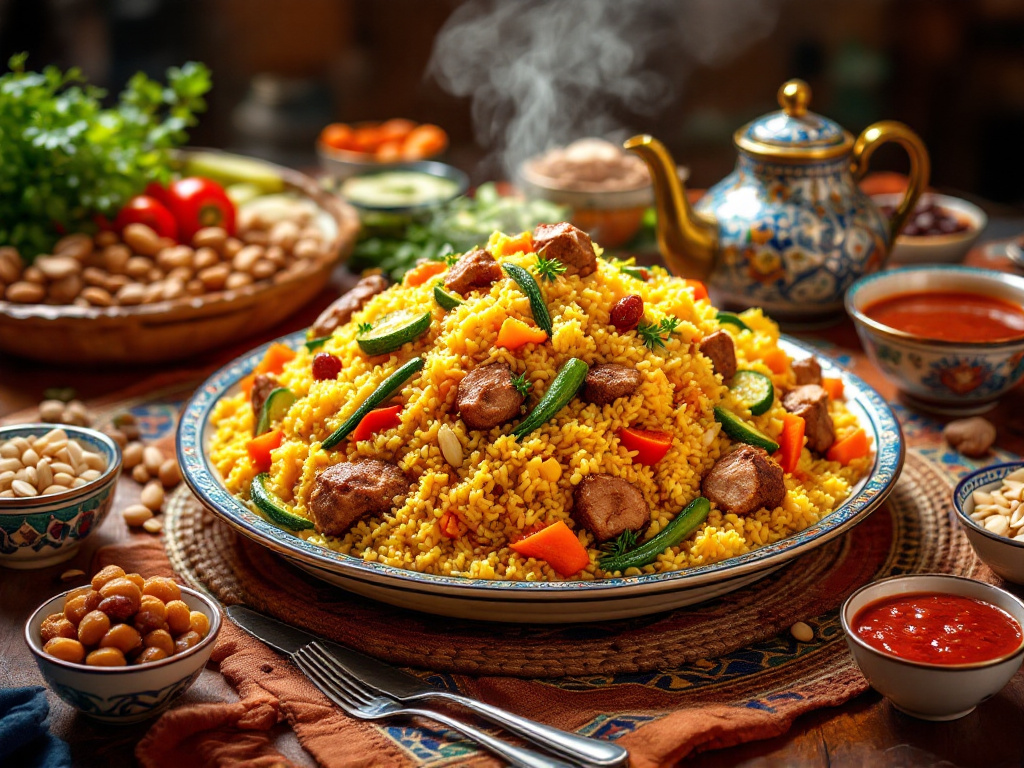
No Moroccan meal is complete without couscous, a staple that embodies the Flavors of Morocco.This fluffy semolina dish is traditionally steamed and served with a hearty stew of vegetables, meat (usually lamb or chicken), and chickpeas. It’s a dish that brings families together, often enjoyed on Fridays, the holy day in Morocco.
Ingredients
Couscous is a versatile dish, and the ingredients can vary depending on the recipe. Here’s a common list for Traditional Moroccan Couscous with Vegetables:
- Couscous grains: 2 cups (preferably medium or fine grain).
- Vegetables:
- 2 carrots (peeled and cut into chunks).
- 2 zucchinis (cut into chunks).
- 1 sweet potato (peeled and cubed).
- 1 turnip (peeled and cubed).
- 1-2 tomatoes (grated or chopped).
- 1 onion (finely chopped).
- Chickpeas: 1 cup (cooked or canned).
- Raisins: 1/2 cup (optional, for sweetness).
- Spices:
- 1 tsp ground turmeric.
- 1 tsp ground ginger.
- 1 tsp paprika.
- 1/2 tsp cinnamon (optional).
- Salt and pepper to taste.
- Olive oil: 2-3 tbsp.
- Water or vegetable/chicken stock: 4-5 cups.
- Fresh herbs: Parsley or cilantro, chopped (for garnish).
Optional additions: lamb, chicken, or beef for a non-vegetarian version.
Preparation Technique
- Prepare the couscous grains:
- Place the couscous in a large bowl.
- Add 1-2 tbsp of olive oil and a pinch of salt, then mix with your hands to coat the grains.
- Pour 1.5 cups of boiling water or stock over the couscous, cover, and let it sit for 5-10 minutes.
- Fluff the grains with a fork to separate them.
- Cook the vegetables:
- Heat olive oil in a large pot or couscoussier (a traditional steamer).
- Sauté the onions until softened, then add the tomatoes and spices (turmeric, ginger, paprika, cinnamon, salt, and pepper).
- Add the carrots, sweet potato, turnip, and enough water or stock to cover the vegetables. Simmer for 15-20 minutes.
- Add the zucchini and chickpeas, cooking for another 10-15 minutes until all vegetables are tender.
- Steam the couscous (optional for traditional method):
- Place the couscous in the steamer basket of a couscoussier and steam it over the simmering vegetables for 10-15 minutes. This step enhances the texture and flavor of the couscous.
- Assemble the dish:
- Serve the couscous grains on a large platter.
- Arrange the vegetables and chickpeas on top, pouring some of the broth over the dish.
- Garnish with fresh parsley or cilantro and serve with extra broth on the side.
Time
- Preparation: 15-20 minutes.
- Cooking: 30-40 minutes.
- Total: Approximately 45-60 minutes.
Difficulty
- Level: Easy to moderate.
- The recipe is simple, but steaming the couscous (if done traditionally) requires some attention.
Benefits
- Nutritional value:
- Couscous is a good source of carbohydrates and fiber.
- The vegetables provide vitamins, minerals, and antioxidants.
- Chickpeas add plant-based protein and fiber.
- Customizable:
- Can be made vegetarian, vegan, or with meat depending on your preference.
- Balanced meal:
- Combines grains, vegetables, and protein for a complete and satisfying dish.
- Cultural significance:
- Couscous is a staple in Moroccan cuisine and is often served during family gatherings and celebrations.
What Makes Couscous Special:
- It’s incredibly versatile and can be customized with your favorite ingredients.
- It’s a symbol of togetherness, often served in large communal dishes.
Why You’ll Love It: A comforting and nutritious meal that’s both filling and satisfying, couscous is a must-try for anyone exploring Moroccan cuisine.
3. Pastilla: A Sweet and Savory Delight
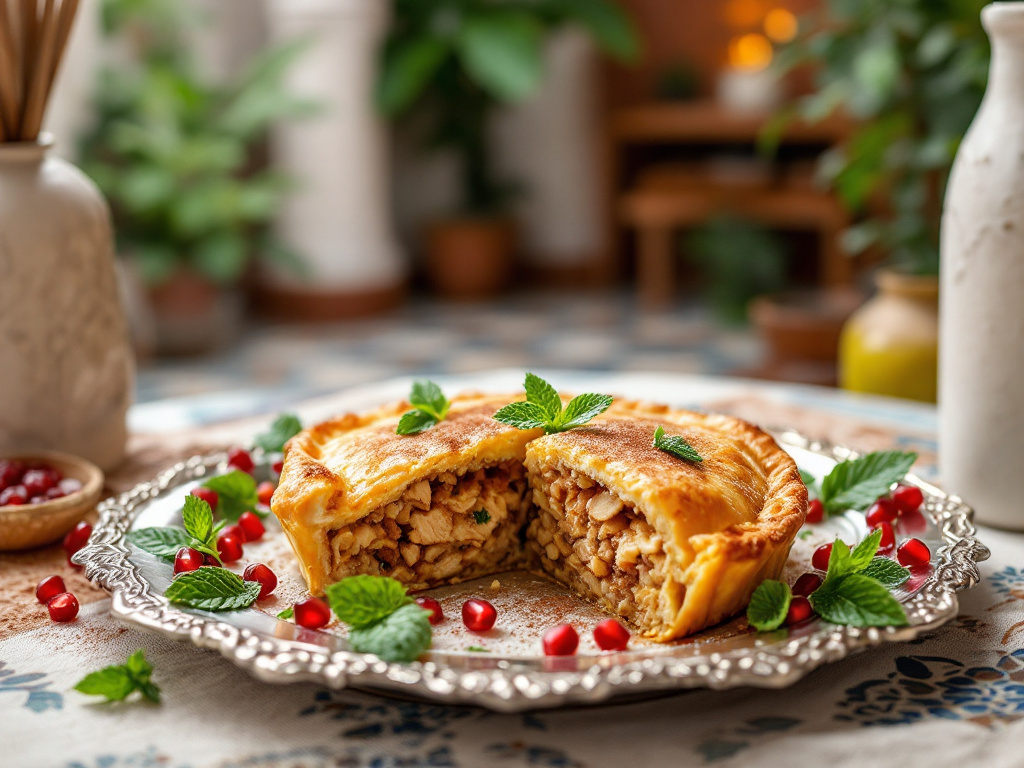
No Moroccan meal is complete without couscous, a staple that embodies the Flavors of Morocco.This fluffy semolina dish is traditionally steamed and served with a hearty stew of vegetables, meat (usually lamb or chicken), and chickpeas. It’s a dish that brings families together, often enjoyed on Fridays, the holy day in Morocco.
Ingredients
Pastilla (or Bastilla) is a traditional Moroccan savory-sweet pie that captures the essence of the Flavors of Morocco, often made with chicken or pigeon, almonds, and a delicate phyllo dough crust.Here’s a common list of ingredients for Chicken Pastilla:
- For the filling:
- 1 whole chicken (or 4-6 chicken thighs).
- 2 large onions, finely chopped.
- 3-4 garlic cloves, minced.
- 1/2 cup chopped parsley and cilantro.
- 1 tsp ground ginger.
- 1 tsp ground cinnamon.
- 1/2 tsp turmeric.
- 1/2 tsp saffron threads (optional).
- Salt and pepper to taste.
- 1/2 cup water or chicken stock.
- For the almond mixture:
- 1 cup blanched almonds, toasted and ground.
- 1/4 cup powdered sugar.
- 1 tsp ground cinnamon.
- For the egg mixture:
- 4-5 eggs, beaten.
- For the crust:
- 8-10 sheets of phyllo dough (or warqa, a traditional Moroccan pastry).
- 1/2 cup melted butter (for brushing the dough).
- For garnish:
- Powdered sugar and ground cinnamon.
Preparation Technique
- Cook the chicken filling:
- Heat olive oil in a large pot. Add the onions and garlic, cooking until softened.
- Add the chicken, spices (ginger, cinnamon, turmeric, saffron, salt, and pepper), parsley, and cilantro.
- Pour in water or chicken stock, cover, and simmer for 30-40 minutes until the chicken is tender.
- Remove the chicken, shred the meat, and set aside.
- Prepare the egg mixture:
- Reduce the sauce left in the pot by simmering it until thickened.
- Slowly stir in the beaten eggs, cooking until the mixture becomes creamy.
- Prepare the almond mixture:
- Toast the almonds in a pan or oven until golden.
- Grind them coarsely and mix with powdered sugar and cinnamon.
- Assemble the pastilla:
- Preheat the oven to 375°F (190°C).
- Brush a round baking dish with melted butter.
- Layer 4-5 sheets of phyllo dough (or warqa) in the dish, overlapping them and letting the edges hang over the sides. Brush each sheet with melted butter.
- Add a layer of the egg mixture, followed by the shredded chicken, and then the almond mixture.
- Fold the overhanging dough over the filling, sealing it. Add 2-3 more sheets of phyllo on top, tucking the edges underneath and brushing with butter.
- Bake the pastilla:
- Bake for 25-30 minutes, or until golden and crispy.
- Garnish and serve:
- Dust the top with powdered sugar and ground cinnamon in a decorative pattern before serving.
Time
- Preparation: 30-40 minutes.
- Cooking: 1 hour.
- Total: Approximately 1.5-2 hours.
Difficulty
- Level: Moderate to advanced.
- The recipe involves multiple steps (cooking the filling, assembling the layers), but it’s manageable with patience.
Benefits
- Rich in flavor:
- Combines savory, sweet, and aromatic spices for a unique and unforgettable taste.
- High in protein:
- Chicken, eggs, and almonds provide a good source of protein.
- Cultural significance:
- Pastilla is a celebratory dish often served at weddings, holidays, and special occasions in Morocco.
- Customizable:
- Can be made with pigeon (traditional), chicken, seafood, or even vegetarian fillings.
- Impressive presentation:
- The golden, flaky crust and decorative sugar-cinnamon topping make it a show-stopping dish for guests.
WWhat Makes Pastilla Special:
- It’s a unique blend of sweet and savory flavors, combining spiced meat, almonds, and a flaky pastry crust.
- It’s a dish of celebration, often served at weddings and special occasions in Morocco.
Why You’ll Love It:
A rich and flavorful dish with a perfect balance of textures, pastilla is a must-try for anyone exploring Moroccan cuisine.
4. Harira: The Soup That Nourishes the Soul
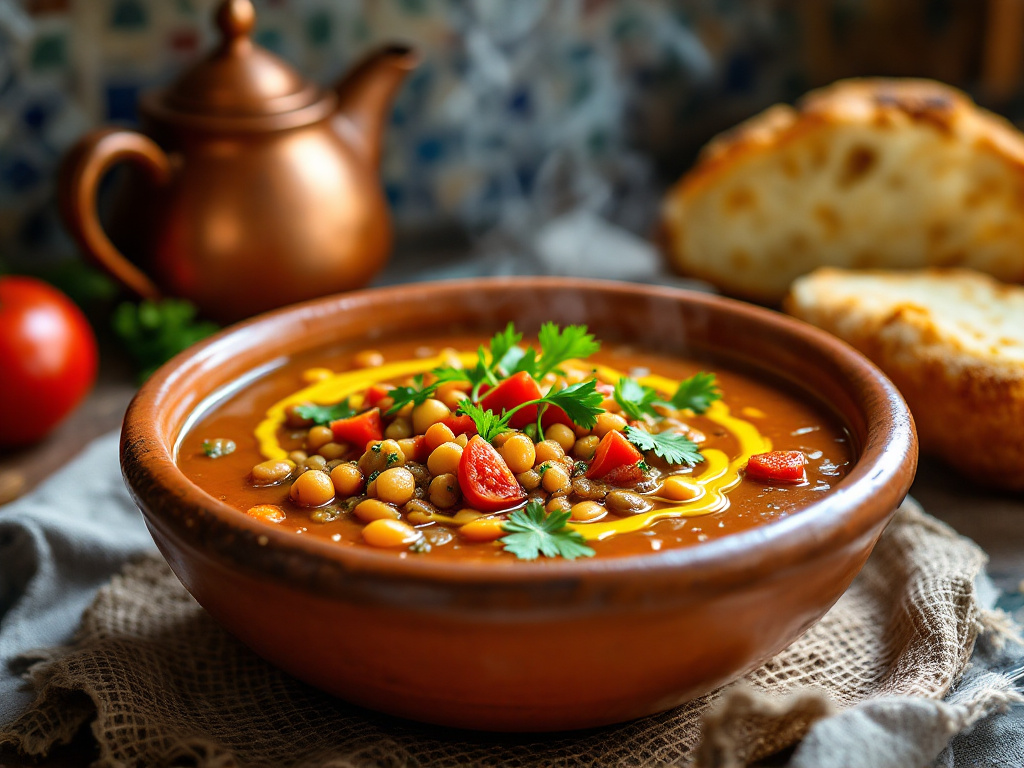
Harira is one of the most iconic Flavors of Morocco, often enjoyed during Ramadan to break the fast.This hearty and flavorful soup is made with tomatoes, lentils, chickpeas, lamb, and a blend of spices like ginger and turmeric. It’s thickened with flour and often garnished with fresh herbs like cilantro and parsley.
Harira is a traditional Moroccan soup, often served during Ramadan to break the fast. It’s hearty, flavorful, and packed with nutrients. Here’s a common list of ingredients:
- Protein:
- 1/2 lb (250g) beef or lamb, cut into small pieces (optional for a vegetarian version).
- 1 cup cooked or canned chickpeas.
- 1/2 cup dried lentils, rinsed.
- Vegetables and base:
- 1 large onion, finely chopped.
- 2-3 ripe tomatoes, grated or blended.
- 2-3 celery stalks, finely chopped.
- 1/4 cup fresh parsley, chopped.
- 1/4 cup fresh cilantro, chopped.
- Spices:
- 1 tsp ground turmeric.
- 1 tsp ground ginger.
- 1 tsp paprika.
- 1/2 tsp cinnamon (optional).
- Salt and pepper to taste.
- Other ingredients:
- 2 tbsp tomato paste.
- 1/4 cup flour (to thicken the soup).
- 6-8 cups water or beef/chicken stock.
- Juice of 1/2 lemon (optional, for serving).
Optional additions: vermicelli noodles or rice for extra texture.
Preparation Technique
- Cook the meat and base:
- Heat olive oil in a large pot. Add the chopped onion, celery, parsley, and cilantro, and sauté until softened.
- Add the meat (if using) and spices (turmeric, ginger, paprika, cinnamon, salt, and pepper). Cook for 5-7 minutes until the meat is browned.
- Add the tomatoes and liquid:
- Stir in the grated tomatoes and tomato paste. Cook for 5 minutes to blend the flavors.
- Add the lentils, chickpeas, and water or stock. Bring to a boil, then reduce the heat and simmer for 30-40 minutes, or until the lentils are tender.
- Thicken the soup:
- In a small bowl, mix the flour with a bit of water to create a smooth slurry. Slowly pour this into the soup while stirring to avoid lumps.
- Simmer for another 10-15 minutes until the soup thickens.
- Optional additions:
- If using vermicelli noodles or rice, add them during the last 10 minutes of cooking.
- Serve:
- Ladle the harira into bowls and garnish with a squeeze of lemon juice and extra cilantro, if desired.
Time
- Preparation: 15-20 minutes.
- Cooking: 1-1.5 hours.
- Total: Approximately 1.5-2 hours.
Difficulty
- Level: Easy to moderate.
- The recipe is straightforward, but it requires some time for simmering and thickening.
Benefits
- Nutritional value:
- High in protein (from meat, chickpeas, and lentils) and fiber (from legumes and vegetables).
- Packed with vitamins and minerals from fresh herbs and vegetables.
- Hearty and filling:
- Harira is a complete meal in itself, perfect for breaking a fast or as a comforting dish on cold days.
- Customizable:
- Can be made vegetarian or vegan by omitting the meat and using vegetable stock.
- Cultural significance:
- A staple during Ramadan, harira is a symbol of Moroccan hospitality and tradition.
- Flavorful and aromatic:
- The combination of spices, fresh herbs, and slow cooking creates a rich and satisfying flavor.
Why Harira is Special:
- It’s more than just a soup—it’s a symbol of warmth and hospitality.
- It’s perfect for chilly evenings or as a nourishing pick-me-up.
Why You’ll Love It: A bowis like a warm hug, offering comfort and satisfaction with every spoonful.
5. Moroccan Mint Tea: The Drink That Defines Hospitality
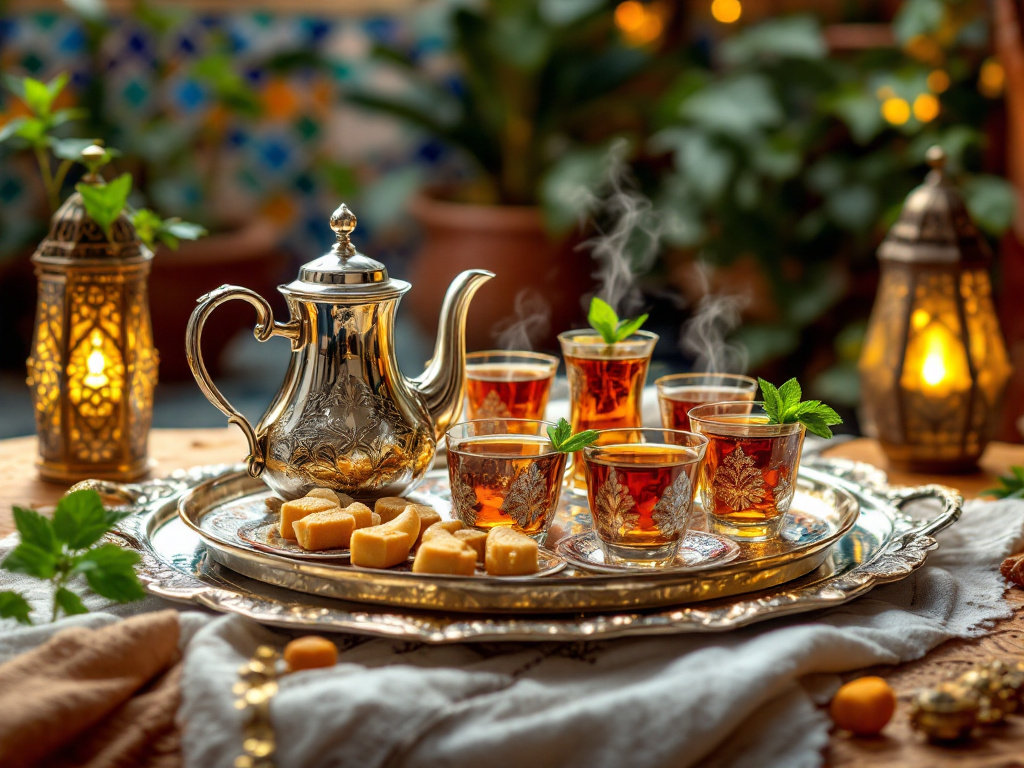
whiskey” and is a big part of Moroccan life. It’s made with green tea, fresh mint, and lots of sugar. The tea is poured high to make a foamy top.
The Role of Mint Tea in Moroccan Culture:
- It’s a sign of welcome and friendship.
- It’s given to guests as a sign of respect and enjoyed all day.
Ingredients
Moroccan mint tea, also known as “atay bi nana”, is a staple that encapsulates the Flavors of Morocco and its hospitality and culture. Here’s what you’ll need to make it:
- Green tea: 2 teaspoons (preferably Chinese gunpowder green tea).
- Fresh mint leaves: 1 large handful (about 10-15 sprigs).
- Sugar: 2-4 tablespoons (adjust to taste).
- Water: 4 cups (1 liter).
Optional: A few drops of orange blossom water for added aroma.
Preparation Technique
- Boil the water:
- Bring 4 cups of water to a boil in a kettle or pot.
- Rinse the tea leaves:
- Place the green tea leaves in a teapot (traditionally a Moroccan metal teapot).
- Pour about 1/2 cup of boiling water over the tea leaves, swirl it around, and then discard the water. This step removes bitterness and cleans the tea leaves.
- Brew the tea:
- Add the fresh mint leaves and sugar to the teapot with the rinsed tea leaves.
- Pour the remaining boiling water into the teapot.
- Mix the tea:
- To mix the flavors, pour the tea into a glass and then return it to the teapot. Repeat this process 2-3 times. This also helps aerate the tea, giving it a frothy top when served.
- Serve:
- Pour the tea into small glasses from a height (about 6-12 inches above the glass). This creates a frothy layer on top, which is a signature of Moroccan mint tea.
Time
- Preparation: 5 minutes.
- Brewing and serving: 5-10 minutes.
- Total: Approximately 10-15 minutes.
Difficulty
- Level: Easy.
- The process is simple, but achieving the perfect balance of sweetness and mint flavor may take some practice.
Benefits
- Digestive aid:
- Mint tea is known for its soothing properties, helping with digestion and reducing bloating.
- Hydrating and refreshing:
- Served hot, it’s comforting, but the mint also makes it refreshing, even in warm weather.
- Cultural experience:
- Drinking Moroccan mint tea is a social ritual, symbolizing hospitality and friendship.
- Rich in antioxidants:
- Green tea is packed with antioxidants, which can boost overall health.
- Customizable:
- You can adjust the sweetness, mint intensity, or even add orange blossom water for a unique twist.
Why You’ll Love It: Moroccan mint tea is light, refreshing, and full of flavor. It’s perfect after a meal or a long day., and aromatic, Moroccan mint tea is the perfect way to end a meal or relax after a long day.
Conclusion: Explore Morocco Through Its Cuisine
The Art of Moroccan Cuisine is a treat for all your senses, combining the unique Flavors of Morocco, textures, and smells that show off the country’s rich culture. From the famous tagine to the comforting harira, each dish has its own story and invites you to experience the warmth and hospitality of Morocco.
Ready to Discover the Flavors of Morocco?
Start your Moroccan food journey by cooking these dishes at home or by visiting a Moroccan restaurant. These 5 traditional Moroccan dishes are a great way to begin. So, why wait? Explore Morocco’s flavors and let your taste buds travel to this magical North African country.
FAQs About Moroccan Cuisine
1. What makes the Flavors of Morocco unique?
The Flavors of Morocco are known for their bold use of spices, sweet and savory combinations, and influences from Berber, Arab, Andalusian, and Mediterranean cultures.
2. Can I recreate the Flavors of Morocco at home?
Absolutely! Many Moroccan dishes, like tagine and couscous, are easy to prepare with the right ingredients and a bit of patience.
3.Where can I find authentic ingredients to experience the Flavors of Morocco?
Look for Middle Eastern or North African grocery stores, or check online for specialty spice blends like ras el hanout.
4What is a tagine, and why is it so special to the Flavors of Morocco?
A tagine is both a traditional Moroccan dish and the cone-shaped clay pot in which it is cooked. Its design allows steam to circulate, concentrating flavors and keeping the food tender and juicy.
5.Do I need a tagine to cook the Flavors of Morocco?
Not necessarily. While a tagine is ideal, you can use a heavy-bottomed pot or a casserole dish with a lid to achieve similar results.
6. What is ras el hanout, and how does it contribute to the Flavors of Morocco?
Ras el hanout is a Moroccan spice blend that can include up to 30 ingredients, such as cinnamon, turmeric, ginger, cumin, and pepper. Its name means “the best of the shop,” as each vendor has their own unique recipe.
7.What sweet dishes are typical in the Flavors of Morocco?
Some popular desserts include:
- Chebakia: fried cookies coated in honey and sesame seeds.
- Sweet bastilla: a pastry filled with almonds and dusted with powdered sugar.
- Kaab el ghzal: crescent-shaped cookies filled with almond paste.
8. What drinks complement the Flavors of Morocco?
Mint tea is the most iconic drink. It’s made with green tea, fresh mint leaves, and sugar, and is served as a symbol of hospitality.
9.What kind of bread complements the Flavors of Morocco?
Moroccan bread, called khobz, is round and flat with a dense texture. It’s used to accompany meals and scoop up food instead of using utensils.
10. What role do dates play in the Flavors of Morocco?
Dates are an essential ingredient in both sweet and savory dishes. They are also served as a snack or side dish, especially during Ramadan.
11.What is harira, and how does it embody the Flavors of Morocco?
Harira is a traditional Moroccan soup made with lentils, chickpeas, tomatoes, and spices. It’s especially popular during Ramadan to break the fast.
12.Are the Flavors of Morocco spicy?
It’s not usually spicy but is very flavorful and aromatic. The dishes balance sweet, savory, and tangy flavors. If you prefer more heat, you can add harissa, a chili paste.
Would you like to explore any of these topics further or get a recipe?
Share Your Experience!
What’s your favorite Moroccan dish? Have you tried an don’t forget to share this article with fellow food lovers!
